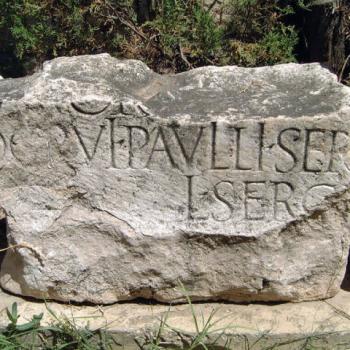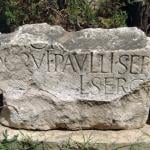LAYING IT ON THE LINE: THE ROLE OF LAITY IN MINISTRY THEN AND NOW (A Lecture Given in Houston)
Ben Witherington, III
I have been reading an important recent volume by Ramsay MacMullen, the doyen of social historians, now retired from Yale—The Second Church. A.D. 200-400 (SBL 2009). In this volume, MacMullen chronicles in detail, region by region throughout the Mediterranean world how the church, its leadership structures, and its buildings developed over that period of time, with the great watershed assumed to be the rise of Constantine to power, empowering Christianity to be a licit or legal religion. What is more than a little clear from this survey is something we have all known all along— the so-called laity make up 95% of all Christians in any given age, and more importantly determine the majority of its day to day practices. The problem of course is, that laity in antiquity were largely illiterate— only 15% of the general populous could read or write, and so the literary deposit or record reflects the elite leadership of the movement, in particular those we would call theologians or clergy.
How do we find out what the laity were up to in the ancient church if they did not leave much if any literary evidence? The answer is we find the evidence through archaeological work, and through reading inscriptions on stele and gravestones and the like. We look at funerary art and consider the day to day practices of ancient Christianity. What were these practices? Most of them will not surprise you.
First of all there was care for the widows and orphans, the ill and infirm. This of course was an extension of the practices in early Judaism, and more to the point an extension of what not only Jesus told his disciples to do (see the parable in Mt. 25 of the sheep and goats),but the praxis of the Jerusalem Church according to Acts 2-6. In the very earliest period there was no clergy/laity distinction at all—a matter I have already discussed in my first lecture. Here it must suffice to say that the concept of the priesthood of all believers was tied to the notion that with the beginning of church history we had entered the eschatological age, when all are prophets, all are priests, and equally all are part of the laos, from which we get the term laity. It is in fact the Greek word which simply means ‘the people’.
Secondly, there was the crucial matter of providing space where there could be gatherings of Christians. Christianity in the first four centuries of its existence was not a legal, recognized religion, and when it became increasingly apparent it was not simply a form of Judaism, it became an endangered species. Unlike our own culture where it is assumed ‘the newest is the truest and the latest is the greatest’ just the opposite was assumed in the Biblical world, especially when it came to religion. The religion needed to be ancient if it was to be considered true, time tested, valid. So where could this ‘new’ religion of the Good News meet? Not in public purpose built buildings. There would be far too much opposition from the majority in a religiously pluralistic setting.
If you wonder why it is today that there is so much ferment and fervor about the removal of the signs of Biblical religion from the public sphere (e.g. the ten commandments, crosses etc) it is because we are becoming a religiously much more pluralistic culture, like the ancient world, and what pluralism has a hard time accepting or tolerating is any sort of claims that this or that religion is the one true religion that supplants all other.
Christianity of necessity needed to meet in private homes in such a pluralistic culture, and it was the elite local laity that provided such venues—people who actually had homes where such meetings could transpire— a Lydia in Philippi, a Phoebe in a suburb of Corinth, a Stephanas in Corinth, an Aquila and Priscilla in Ephesus, and so on. If you read the list of greetings in Romans 16 you quickly learn how many different small gatherings of Christians there were in homes. And this practice went on for centuries. In fact, what happened is that people renovated their homes, knocking out walls to create space for a worship center, a baptistery, a place for catchumens to meet within the confines of a villa.
Thirdly, lay people, both men and women, did a good deal of the cathecising of new converts. We see this already in the Pastoral Epistles and elsewhere in the NT, but this in turn implied they had been trained, been educated, even if they were not literate in some cases. We have the stories of women who became martyrs for the faith (e.g. Perpetua) and who were enormously popular because of what they had done for others before they died. Women were the conveyors of cultural custom and its proprieties, they were the keepers of the hearth and home, the preservers of the family’s honor and warding off shame in that world. And what a different world it was than ours. I will digress for a moment to show you just how different it was.
DISCUSS HONOR AND SHAME, DYADIC PERSONALITY, RECIPROCITY CULTURE, PATRONAGE, LIMITED GOOD, PATRIARCHY.
What is interesting about the church in regard to these factors is that the church at its inception set about the deconstruct a good deal of these basic ‘family’ values of antiquity in various ways, not the least of which is deconstructing the requirement that women be married, have children, and stay at home.
Whether it is the story of folk like Lydia or Phoebe, or later women like Thecla or Pereptua, single lay women played important roles and provided paradigms for the justification of single women doing ministry in the earliest church. It was Jesus himself of course who told his followers they had two blessed options— celibacy in singleness or fidelity in marriage. This in itself radicalized what was possible for his female followers to do. And Jesus knew nothing of a clergy-laity distinction, much less one divided along gender lines. The first Easter sermon was preached by a lay woman commissioned by Jesus himself to go tell the men “he is risen.” Her name was Miryam of Migdal, whom we know as Mary Magdalene.
What MacMullen is mainly interested in is what is often called folk religion, but what I will call the ordinary religious practices of people who were not priests, Levites or the like. And what he tells us is very revealing. Let us talk first about what lay people believed in the Biblical world. For one thing they did not believed that the dead were gone, by which I mean, they mostly believed the dead were alive in the afterlife, and could be communicated with, and indeed could be fellowshipped with.
We see a vestigial piece of evidence of this sort of belief in 1 Cor. 15 where Paul talks about proxy baptism for the dead which some Corinthian laity are engaging in. But from slightly later Christian sources we have tales of Christians meeting in cemeteries to celebrate the anniversary of the birth or death of a loved one. They would have meals on the tomb itself, and indeed there would be a pouring spout into the tomb so the departed could share the wine as well! There would be dancing and singing in the graveyard on such an occasion, especially if what was being celebrated was a departed martyr like Perpetua. Worship in graveyards, apparently led by laity was one of the few forms of open air public worship in Christian antiquity. The only time I’ve seen anything remotely like this is on Easter Sunday morning, and no one was pouring wine into the tombstone! This brings me to a very important point.
Folk or lay religion is often more apt to reflect the wider cultural mores and customs. What I am talking about is simply the Christian adaptation of widespread pagan practices in regard to celebrating with the dead. And this brings us to an even more crucial point— sincerity and deep felt piety is no guarantee of Biblical accuracy of practice. Lay persons continued the hearth and home family religion practices they had learned when they grew up as pagans. They made modifications of course in the name of the deity solicited, but the actual praxis was very much the same as Christian graveyards from all over the ancient world from the period A.D. 200-400 show. There are mensa, which is to say preformed tomb top built in eating treys on many of these tombs. Picnic with the beloved dead was in the offing. If this sounds strange to you, I mention it as a reminder of just how captive we all are to the culture in which we grow up. Like fish in the sea who know nothing of life on land, culture is the air we breath, the assumptions we accept, the practices we never scrutinize and assume to be normal or even normative. But alas, our culture like ancient Greco-Roman culture is hardly very Christian at heart. And this is precisely why we need critical cultural analysis and self-examination in order to do ministry of any kind in this ever changing land.
Christianity in antiquity needed its Bible scholars to help them do things in a way that comported with the faith and praxis of their sacred sources, and they still do now. I frankly have been appalled at what passes for the use of the Bible in so many resources written by lay people to help them study the Bible. Yes, I am talking about Beth Moore and some of that sort of curriculum. Laity may not need clergy guidance for this or that practice or activity such as a Bible study, but nor is it sufficient for them to do Bible study, generate ministries and the like without careful and prayerful study of the Scriptures with the help of scholars and good scholarly resources. Happily, this does happen today, but just not often enough. I suppose in the Protestant tradition it is because people assume that all they need to understand the Bible is their brains and a good translation that good commentaries on Bible books are too seldom consulted. But a moment’s reflection will show that the brains and Bible and Spirit plus nothing approach is sadly deficient, because what happens of course is that any active reader without guidance reads their own culture and preferences and ideas into the Biblical text.
Folk or lay Christian religion in the homes in antiquity was also a continuation of the wider cultural practices. You can of course see this from the household codes in Colossians and Ephesians where Paul has to address slaves and chastise slave owners to treat others as real human beings, never mind as Christian brothers and sisters. The apostles had to deal with life as they found it, and they put the yeast of the Gospel in the dough of culture as they found it, not directly, but in the context of the largely Christian home. This led to a gradual modification of social mores amongst Christians, not an instantaneous one.
There would be prayers in the home, and their continued to be a cabinet, sometimes containing the death masks of their ancestors, which when the head of the family opened the cabinet he might well consult the spirit of the ancestor, which was called the ‘genius’ (from which we get both the word genie, and the word genius) when guidance was needed. This led in the church to the consultation of the saints and Mary in prayer. Here again there was need of some Biblical correction of these wider cultural practices, a sort of correction scholars then and now could provide. Sometimes the correction was accepted, sometimes resisted, sometimes simply ignored.
Laity in antiquity often took charge of the social gospel ministries of feeding the poor, clothing the naked, and finding shelter for the street people. The more things change, the more they stay the same. But what is less well known is that lay people were in charge in antiquity of the medical side of things as well— they were the doctors and nurses, except in cases where it was believed that holy communion might be needed by the dying, or the like. Julian the Apostate, born a Christian, but returning to his pagan roots, once complained about the churches in his post-Constantinian era that the reason the pagan temples were increasingly empty and the churches increasingly full was because the indigent and poor and diseased were ministered to by ordinary folk who would lead them into the church and help them there. In our current environment of economic distress, it would be well to remember that we are indeed serving a master who said “blessed are the poor” and called us to serve them.
II Ministry Now
These reflections have been intended to spark a deliberate rethinking about lay ministry now, in light of lay ministry at the beginning of Christianity, and it is all the more necessary we do so, since, we live in an increasingly post-Christian era. I was lecturing in Houston last year at St. Mary’s Seminary. They had a good year and graduated about ten priests—- unfortunately they needed about 30!! Their Hispanic ministry is booming and increasingly lay people are picking up the slack. We hear a lot these days about Emergent and Emerging Churches where the clergy and laity distinction has disappeared altogether.
What has not disappeared in these churches is a leader and follower distinction, and some sort of leadership structure. We do however, even in mainline Protestant setting see the breaking down of the dividing wall between clergy and laity when it comes to Word, order, and sacrament, Laity are increasingly involved in all three, and I do not see this as a bad thing in any way. What I do say is that it requires education and training especially to do those sorts of ministries properly and carefully and prayerfully.
So it is that we need events precisely like this one where laity have their consciousness raised about their need for committing themselves to life long learning if they are committing themselves to various ministries. There is much to be learned not just from the Scriptures, but also from the Christian past about how such ministries can and should be undertaken. This brings me to the point of saying that now more than ever lay people need seminaries, and need better training as they become increasingly involved in all kinds of ministry. And not just the training that comes from mentoring, and experiential kinds of learning, but actual education.
Lay education is not merely a desideratum, it is a necessity as lay people do more and more of the ministry. The word of the scripture to clergy is the same as the word of the scripture to laity— study to find yourself approved, and furthermore, study using good resources, not just anything you happened upon whilst surfing the net! Most of the free resources you find online for Biblical studies are: 1) badly out of date and out of print; or 2) not worth the pixels they are using up to display on your screen; or 3) really bad and misleading information.
Here then the good news. Seminary and Biblical education, good training, is more readily available now than at any time in human history not only through the wonders of online education, but also by means of the commitment of seminaries to do distance education well. My own school Asbury has launched an ACE (Asbury Cluster Education) program in Columbus Ohio, and you may well see it coming to a venue near you someday. My suggestion is, you take advantage of it. Conferences are nice as learning experiences but they are no substitute for real intensive education with feed back and evaluation, something we all need.
But something more needs to be stressed. Worship is the signal act of Christianity pointing the world not merely toward God, but towards the practice of praising, petitioning, adoring, thanking, serving God. On any given Sunday in any given church, worship is largely attended by lay people and should deeply involve the gifts and graces of lay people. This is too often neglected, or the service is too clergy dominated or regimented to allow for such participation except in small anecdotal ways (giving the announcements, reading the Scripture for the day etc.). What has happened in post-modern Protestant worship is that too often it has been turned into a performance of the few for the many couch potatoes for Jesus in the pews. Worship has been turned into entertainment, into Stand Up Spotlight, and while the people are often entertained they are not so often edified and challenged and God is too seldom adored and glorified. But worship is not meant to be a spectator sport like Houston Texan football. It is meant to be a participatory event in which we all get caught up in love and wonder and praise of our God. If lay persons would more vibrantly, vigorously, vivaciously enter into worship in spirit and in truth, both regular worship and revival services and evangelistic services, if they would insist on all creatures great and small entering into worship, into the presence of the Holy, then we would all become transfixed and transformed and better able to do ministry for the Lord. Lay ministry should be energized by vibrant participation in worship as the spring board for a week of Christian service, bearing in mind that those who wait on and worship the Lord will renew their strength. They will mount up like eagles with wings of great length. They will run and not grow weary, they will walk and not faint, and bring rest, restoration, shalom to the weary, and power to the saints. May it always be so in lay ministry. AMEN












